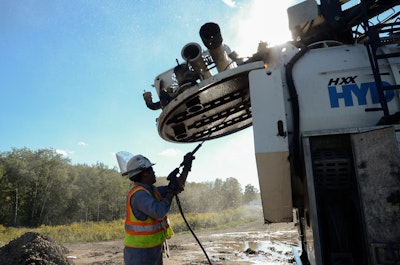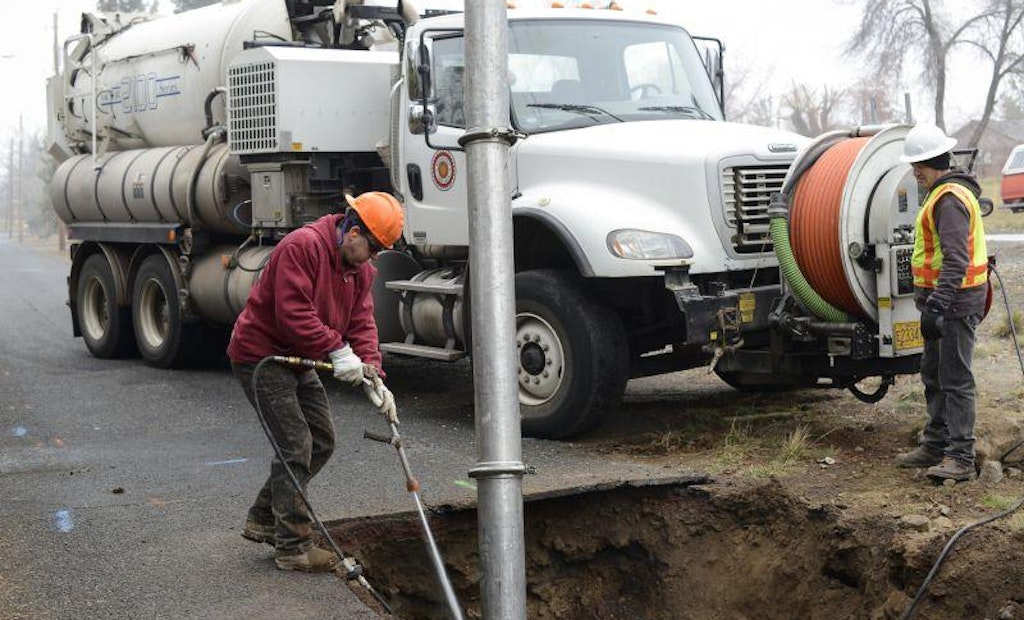Interested in Rehab/Relining?
Get Rehab/Relining articles, news and videos right in your inbox! Sign up now.
Rehab/Relining + Get AlertsWith their ability to dig more safely and efficiently, hydroexcavators are becoming increasingly popular as more municipalities make the investment. Of course, they can only be effective if the various components are working properly.
Imagine being on the job and your machine loses some of its powerful suctioning ability. The tendency may be to crank the machine up to a higher rpm, says Gary Poborsky, founder and owner of GapVax. But that won’t do much good and will only burn more fuel. The culprit in this case could be dirty filter bags.
“It’s just like a shop vac you use around the house,” Poborsky says. “You can tell when the filter starts to get blocked. You can tell you’re losing suction on the end of the hose. You take that filter out, clean it and put it back in, and it makes a big difference. It’s the same thing with a hydroexcavator. You’re going to lose performance (with dirty filter bags).”
There are many components to a hydroexcavator, but filter bags — along with blowers — are two key ones to focus on since they are tied directly to the machine’s vacuuming ability. Without that function working at an optimum level, you’re not taking full advantage of the benefits of hydroexcavation.
1. Blower maintenance
In terms of preventive maintenance, a hydroexcavator blower should require nothing more than checking oil levels and changing out that oil at regular intervals. Keeping up on that basic maintenance practice could lead to tens of thousands of operating hours on the hydroexcavator without major problems.
“We have many customers way in excess of 20,000 hours, and some of them 40,000 hours, whose blowers still function and perform excellent,” Poborsky says.
At Vac-Con, the company’s national service manager Mike Selby has seen the same.
“We have a contractor that does hydroexcavation, along with combination sewer cleaning, and the unit has over 30,000 hours on it,” he says. “It really depends on what the contractor’s equipment replacement cycle is, but it’s not uncommon to see anywhere from eight to 12 years of solid operation.”
The recommended interval for changing out blower oil can vary among equipment manufacturers and also depends on how exactly the machine is being used.
“It depends on how severely they’re operating the unit and then it also depends on the operating temperature. So what we recommend is to follow the manufacturer’s guidelines,” Selby says. “As a general rule of thumb what we recommend is basically 250 hours.”
Poborsky says a maintenance schedule accompanies every GapVax machine sold. Those recommendations include checking blower oil levels prior to each job to ensure there’s enough oil for operation, and changing it every 800 hours when using mineral oil or every 1,600 hours when using synthetic oil. GapVax recommends that the initial oil change occur after the first 200 hours.
Another blower-related preventive maintenance item is regularly greasing the drive shaft if that’s what drives the blower, as is the case with GapVax hydroexcavators. Poborsky says that should be done weekly.
Such practices could mean a reliable machine over the long term as GapVax’s suggested maintenance intervals were all devised with extreme working conditions in mind, Poborsky says.
“Our hydroexcavators are not only a hydroexcavator but also an industrial truck, so they can be used in steel mills and cement plants and power plants. They get used in the worst conditions there are out there,” he says. “The conditions we were keeping in mind were running the trucks hard, around the clock, 24/7.”
2. Filter bag replacement
The purpose of filter bags is to get dirty, as they serve as a last line of defense to protect the blower from all the debris being sucked up during operation. Thus, the maintenance required on filter bags is pretty straightforward: They will need to be replaced from time to time.
Poborsky recommends replacing filter bags annually or every 1,500 to 2,000 operating hours. That interval takes into account the cyclones on GapVax machines that remove most of the moisture and debris from the airstream before it even reaches the filter bags and blower.
3. Running a restriction test
Selby says putting a specific interval on filter bag replacement is difficult though because it’s largely dependent on the machine’s application.
“In hydroexcavation, the whole idea is to use the water that is on board — or the hydro portion — to break up and liquefy the ground enough so that you have adequate separation in the tank,” he says.
But more material will remain in the airstream, reach the filter bags and clog them more quickly in a dry application. That’s why the best way to determine exactly when it’s time to replace filter bags is running a restriction test, Selby says. Turn on the machine, pull free air through it without vacuuming any material, and look at the reading in inches of mercury on the vacuum gauge.
“A majority of machines out there will be 18 inches all the way up to 28 inches. So, as a rule of thumb, if you’re pulling free air and it’s over half of what the rating of the unit is, then the bags need to be cleaned,” Selby says.
A restriction test is a good way to identify possible problems even if the airflow in a machine is designed in a way that doesn’t require filter bags.
“I always go back to the reading on that vacuum gauge,” Selby says. “If there is a restriction, whether it being filters in the airstream or something else in the piping going to the blower, you’re going to see elevated mercury levels.”
A restriction test doesn’t need to be a daily maintenance item though. Poborsky says if a sudden problem arises involving the filter bags, it will be noticeable in the machine’s operation.
“With the filter bags, there’s really nothing that needs to be checked over on a daily basis,” he says. “With contractors on the industrial side who get into some hot material, there could be a situation where a bag breaks or is destroyed. But you would know. It would start blowing dust through the exhaust. Those are the two signs filter bags should be replaced: High restriction and any dust coming out the exhaust.”
4. Watch the exhaust
Selby says the exhaust is something that hydroexcavator operators should always keep an eye on, whether vacuum is being generated via positive displacement or a centrifugal compressor. Not only is material coming out of the exhaust a sign of a problem occurring elsewhere on the machine, noticing it immediately can reduce the amount of damage done to the blower.
“If there is material coming out of that exhaust, that means you’re running material through the blower, which is thus causing damage to the blower,” Selby says. “A centrifugal compressor is much more forgiving on carryover particulate because it doesn’t rely on clearance to generate vacuum (compared to a positive displacement machine). But regardless of what generator it is, if you start pulling material you’re going to do wear (on the equipment). That’s really it.”







